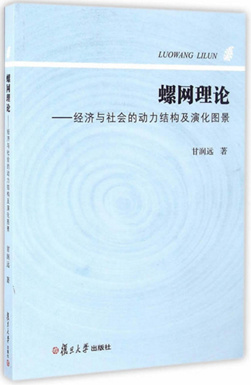New framework for economic theories
Author : ZHU MIN, JIANG JIANG Source : Chinese Social Sciences Today 2017-04-17

Spiral and Net Theory: Dynamic Structure and Evolution of Economy and Society
Author: Gan Runyuan
Publisher: Fudan University Press
Gan Runyuan named his theory the “spiral and net theory” based on his perception that human society advances in a spiral form of escalation, and is also multidimensional like everything else. Gan’s recent Spiral and Net Theory presents its basic idea in the prologue and says “the general landscape of human societal evolution is like a spiral net with multidimensional drives.” It tends to remind people of some law in physical science, while the subtitle “Dynamic Structure and Evolution of Economy and Society” clearly reveals the research object and application of the book.
The author is ambitious enough to establish a theoretical framework featuring a dynamic disequilibrium paradigm. In other words, he means to combine enterprise economics, industrial economics, regional and national economics, as well as state and international economics, and analyze them under the assumption of a comprehensive dynamic disequilibrium, rather than the general equilibrium in neo-classical economics. From the nature of the enterprise to its evolutionary path, from the division of labor life cycles, from economic environment to mechanisms, and the concept of the country to reform, the book introduced various concepts on the micro, medium and macro levels of economics.
Through criticism and inherited wisdom, the book fully absorbs the essence of economics and other social and natural sciences, and refined and sublimated various theories and ideas. Among them, in terms of economics, Gan not only learned from Marxist political economy, but also referenced Western classical economics, neo-classical economics, and super classical economics. There is also a clear main line featuring “essence - environment - elements - structure - efficiency - capacity - power - mechanism – cycle.” It is based on this clue that philosophy, biology, political science, sociology, economics, as well as the system of science and system theory are discussed.
After reading the book, it is not difficult to find the use of system theory to research and transform objects. From the overall point of view, a comprehensive analysis of the relationship between the elements within the system, elements and systems, and systems and the environment is required so as to grasp the essence of regularity to ensure the systems are effectively controlled.
The long-term evolutionary mechanism of the whole human social system revealed by the spiral net theory follows the two laws of bifurcation and coordination, all of which have the unique structure of geometric beauty. From the surface of the social system of humanities and the economic and political system, right through to the depths of the social systems of science, legal and education systems, the book attempts to discuss the fractal features of these systems and economic levels, such as self-similarity, hierarchy and “nestedness.” These are the elements that Yang Chunxue regards as “the most unique and impressive.”
Ye Shengtao made Chinese fairy tales from a wilderness
Ye Shengtao (1894–1988) created the first collection of fairy tales in the history of Chinese children’s literature...
-
How northern ethnicities integrated into Chinese nation
2023-09-18
-
Mogao caves
2023-09-12
-
Mogao Grottoes as ‘a place of pilgrimage’
2023-09-12
-
Time-honored architectural traditions in China
2023-08-29
-
Disentangling the civilizational evolution of China
2023-08-28
-
AI ethics in science fiction
2023-08-23














 2011-2013 by www.cssn.cn. All Rights Reserved
2011-2013 by www.cssn.cn. All Rights Reserved